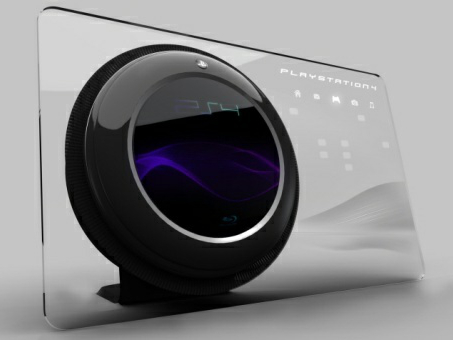Sony's PS4 Will Have Very Large Hard Drive
Sony offered additional information about its upcoming PlayStation 4 console at GDC 2013, hinting that it will ship with a "very large hard drive" without spilling the capacity details. It will also provide a mono microphone/headset right out of the box – no additional purchase is necessary.
Sony Senior Staff Engineer Chris Norden provided a detailed demonstration during the conference, explaining that the eight cores in the 64-bit x86 AMD APU are capable or running eight hardware threads. Each core will use a 32 KiB L1 I-cache and D-cache, and each four-core group will share 2 MiB of L2 Cache. The APU will be able to handle atomics, threads, fibers, and ULTs, with out-of-order execution and advanced ISA.
This APU, the result of a collaboration between AMD and Sony, is based on what Sony calls an extended DirectX 11.1+ feature set. This will include extra debugging support that's not available on the PC, and provide more direct access to the shader pipeline than what was seen with the PlayStation 3. That means developers can do "a lot more cool things and have a lot more access to the power of the system".
According to Ars Technica, the development environment coders will use is based on Windows 7 and is fully integrated with Visual Studio 2010 and 2012, allowing developers to debug PS4 just like they do with PC code. Tools will include C and C++ front ends that are "largely compatible with most standard compilers, and various binary utilities, including CPU and GPU analyzers that can run in real time alongside games".
The report goes on to talk about the console's DualShock 4 controller, the PlayStation 4 Eye camera, and the new user interface. This latter feature will focus on providing users with up-to-date information on all their games from a central menu including DLC news, social recommendations and more without having to actually load a game. The default home screen will provide a digest view of everything that's going on in the social PlayStation space. Sony has even increased the number of friends console owners can have.
As for the PlayStation Eye camera, two are mounted inside the console, each capable of a 1280 × 800 resolution and 60 Hz at a color depth of 12 bits per pixel. The resolution can actually be turned down to increase the response rate. Sony said the Eye will identify where players are physically positioned in a split/screen multiplayer session, and shift the windows around to best suit that player's actual location in front of the TV.
For additional details, check out Ars Technica's report here and CVG's smaller report here.
Get Tom's Hardware's best news and in-depth reviews, straight to your inbox.

Kevin Parrish has over a decade of experience as a writer, editor, and product tester. His work focused on computer hardware, networking equipment, smartphones, tablets, gaming consoles, and other internet-connected devices. His work has appeared in Tom's Hardware, Tom's Guide, Maximum PC, Digital Trends, Android Authority, How-To Geek, Lifewire, and others.
-
danwat1234 1TB is certainly possible since 5400RPM and 7200RPM (Hitachi Travelstar 7K1000) mobile drives are out, but more likely it'll be 500GB or 750GB so cost isn't too highReply -
anxiousinfusion It's going to need to be large (by console standards anyway) if they plan to include downloaded games as a large part of their business.Reply -
bison88 anxiousinfusionIt's going to need to be large (by console standards anyway) if they plan to include downloaded games as a large part of their business.Reply
Depends on whether or not both Sony and Microsoft will start to take full advantage of Bluray capacity and Full 1080p gaming. Textures will be drastically larger in comparisons to what both consoles are capable of now. -
I just bought a 4TB hard drive to make a total of 8 TB on my PC. Anything smaller than a 1TB drive is tiny to me. But then again its a console so who cares other than the 12-25 yr old crowd.Reply
-
janetonly42 "As for the PlayStation Eye camera, two are mounted inside the console," Call me paranoid but these will be covered with electrical tape at my house.Reply -
A Bad Day janetonly42"As for the PlayStation Eye camera, two are mounted inside the console," Call me paranoid but these will be covered with electrical tape at my house.Reply
Don't worry. Microsoft has a patent that covers the concept of a console shutting off if "too many" people are watching a movie that has a set limit on how many people can watch it. The console will give a brief warning period before it stops the movie until the extra people leave.
I'm fairly sure if that's ever implemented, MS would also ensure that should the camera get blocked, the console won't work. -
jalek I replaced my PS3 HDD, but the 60GB would have been fine. The options for anything stored on it are so limited that there's no reason to keep anything on it except games. It had the potential to be a good media server, but it never fulfilled that. I expect the PS4 to do the same, Sony never seems to adapt to it's market, it expects the market to adapt to it's dictates.Reply -
TheMadFapper jintianyurenCrazy Discount! Original XiaoMi M2 Smart Phone 3G Android 4.1 Jelly Bean MIUI OS Quad Core 1.5GHz 4.3 Inch Capacitive Touchscreen 2GB 32GB Version! This Promotion is designed for all our old customers and news customers, thank you very much, so we hold this extremelylow price promotion that never happen in the future. Do not miss it! http://ss.st/bDUjReply
That's not what your mother said last night.
